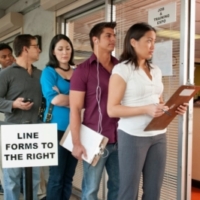Emergency Measures Would Be Needed
If Near-Term Economic Downturn Occurs
Introduction
Unemployment benefits provide critical support to jobless workers, their families and communities, and the U.S. economy. Yet today, the UI system is alarmingly unprepared for the next recession. Permanent reform is needed to ensure the UI system works for all workers at all times, but if a near-term economic downturn occurs, Congress must be prepared to enact emergency measures to address the most significant deficiencies in the current system.
The UI system is a federal and state partnership designed to serve two interlaced purposes: (1) provide economic support to workers and their families to ensure they can afford necessities while they search for new employment that best matches their skills; and (2) steady the overall economy during economic downturns by sustaining consumer demand.
Providing economic support to jobless workers is particularly important for workers of color. Due to systemic racism in the labor market, Black workers, in particular, have higher unemployment rates and face longer periods of unemployment.[1] As a result of historic exclusions from wealth building opportunities, workers of color are also less likely to have sufficient savings to weather periods of unemployment.[2] Unfortunately, the current UI system excludes many more unemployed workers than it covers, with Black workers, other workers of color, and women facing the largest barriers to receiving benefits.
During normal economic times, the failure of the UI system to reach all workers severely undercuts its intended purposes. Such a gap is amplified, however, during economic downturns, particularly the program’s ability to act as an economic stabilizer.
Even as the percentage of unemployed workers receiving UI might rise during recessions, the number of people in need of such benefits greatly increases, and therefore coverage gaps leave more jobless workers without benefits during downturns compared to normal economic conditions. Workers also often have a harder time finding jobs during recessions, so their periods of joblessness tend to be longer. As a result, Congress has stepped in to enact temporary measures designed to try to fill some of the largest gaps in the program during recessions, including addressing low benefit amounts and the number of weeks people can receive benefits.[3]
During the COVID-19 pandemic, Congress continued this tradition and also expanded eligibility to workers who usually do not qualify for UI, including app-based workers who are misclassified as independent contractors,[4] self-employed workers, and some part-time workers. This expansion substantially expanded coverage with roughly 1 in 6 U.S. adults (about 40 million people) receiving UI at the height of the pandemic.[5] Increased benefit amounts also ensured unemployed workers could afford necessities, such as rent and food, helping to keep families above the poverty line and to sustain spending at local businesses.[6]
However, since Congress let the programs expire in September 2021, the proportion of unemployed workers receiving unemployment insurance — known as the recipiency rate — has returned to the pre-pandemic level of about 25 percent, and even many of those unemployed workers who are able to get benefits struggle to survive on the meager amounts.
Congress must begin to address the long-standing systemic issues in the program that shut far too many workers out.[7] Should the economy decline, long-standing problems with the system, as well as continuing impacts from the recent pandemic-induced downturn, would leave millions of workers who lose their jobs with nowhere to turn.
Download the full policy to read more.
Endnotes
[1] Current Population Survey, Bureau of Labor Statistics. See also Gabriel R. Sanchez, Robert Maxim, and Raymond Foxworth, “The Monthly Jobs Report Ignores Native Americans. How Are They Faring Economically?” Brookings, November 10, 2021, https://www.brookings.edu/blog/the-avenue/2021/11/10/the-monthly-jobs-report-ignores-native-americans-how-are-they-faring-economically/.
[2] Angela Hanks, Danyelle Solomon, and Christian E. Weller, “Systemic Inequality,” Center for American Progress, February 21, 2018, https://www.americanprogress.org/article/systematic-inequality/.
[3] Congressional Research Service, “Extending Unemployment Compensation Benefits During Recessions,” October 1, 2014, https://crsreports.congress.gov/product/pdf/RL/RL34340.
[4] For more on the costs of misclassifying app-based workers and other employees as independent contractors, see National Employment Law Project, “Independent Contractor Misclassification Imposes Huge Costs on Workers and Federal and State Treasuries,” October 26, 2020, https://www.nelp.org/publication/independent-contractor-misclassification-imposes-huge-costs-workers-federal-state-treasuries-update-october-2020/.
[5] Patrick Carey et al., “Applying for and receiving unemployment insurance benefits during the coronavirus pandemic,” Monthly Labor Review, U.S. Bureau of Labor Statistics, September 2021, https://doi.org/10.21916/mlr.2021.19.
[6] Amy Traub, “7 Things We Learned About Unemployment Insurance During the Pandemic,” National Employment Law Project, November 16, 2021, https://www.nelp.org/publication/7-things-we-learned-about-unemployment-insurance-during-the-pandemic/.
[7] Josh Bivens et al., “Reforming Unemployment Insurance: Stabilizing a System in Crisis and Laying the Foundation for Equity,” Center for American Progress, Center for Popular Democracy, Economic Policy Institute, Groundwork Collaborative, National Employment Law Project, National Women’s Law Center, and Washington Center for Equitable Growth. June 24, 2021, https://www.nelp.org/publication/reforming-unemployment-insurance-stabilizing-a-system-in-crisis-and-laying-the-foundation-for-equity/.
Related to
Related Resources
All resourcesBoosting Economic Resilience: Seven Ways States Can Support More Workers with Unemployment Insurance

Policy & Data Brief
Case Study: How Virginia Worker Advocates Advanced Unemployment Insurance Reform in a Divided State Government

Policy & Data Brief
Letter on Making Reforms to Virginia’s Unemployment Insurance System

Comments & Letters

